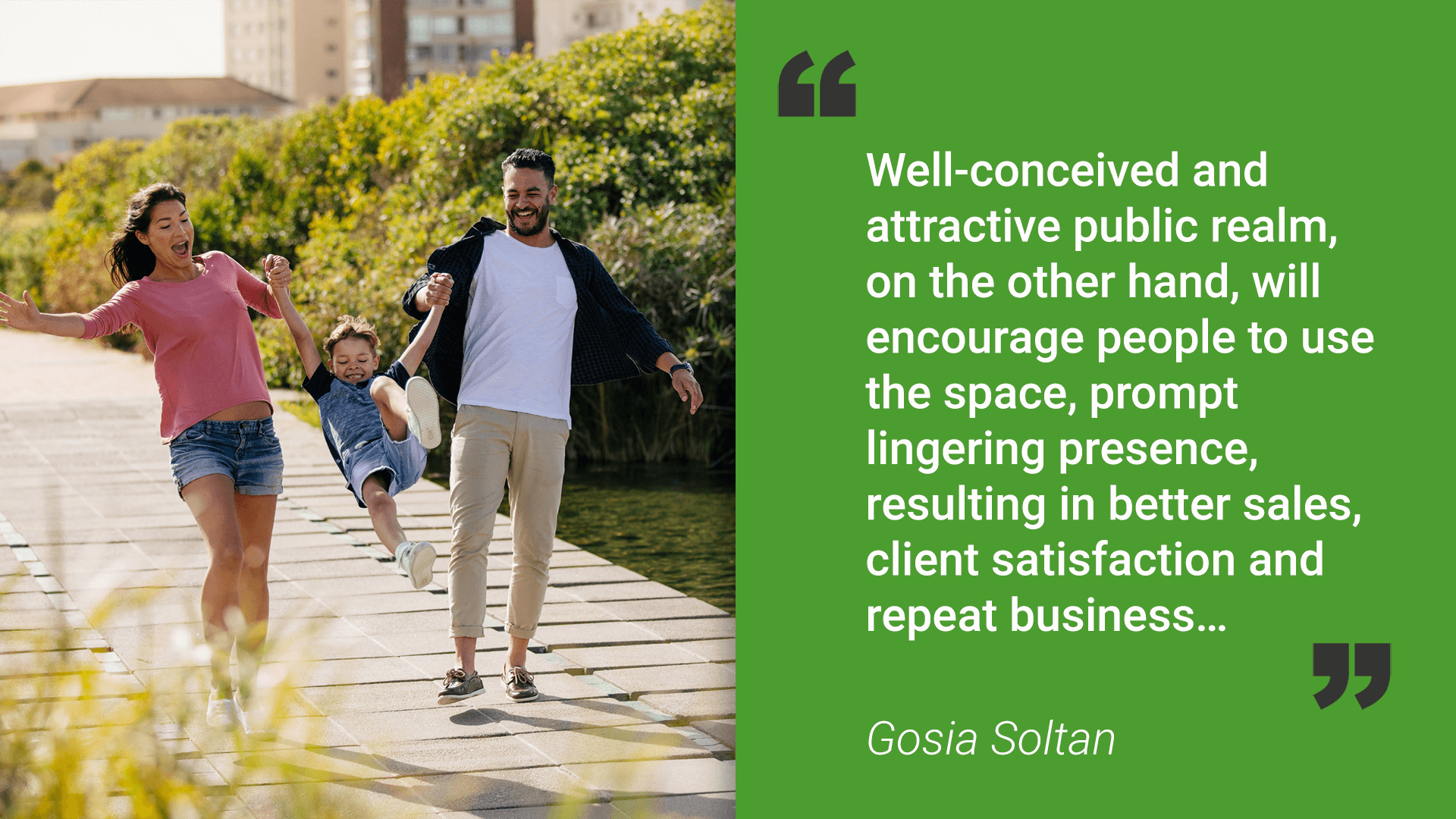Trees and landscape in retail parks and shopping outlets have been a controversial topic ever since I started designing landscape for commercial sites. It sometimes seems that trees are the ‘baddies’ that obscure the visibility of branding and logos and, just as bad, require maintenance due to their leaf and possible fruit drop. The disregard for trees can also sometimes lead to their demise: In historic retail sites and car parks they may have been placed into tree pits too small to give them a chance of survival – so not only were they a cost to plant, but then also a hassle and additional cost to remove, never to be replaced. Alternative plantings such as low-maintenance evergreen shrub beds have been equally mistreated, often outgrown their space and, continually suppressed by rigorous maintenance regimes, now look tired and ill, sending all the wrong signals to the potential customer.
In order to appeal to the new generation of consumer and to mitigate the impact of online shopping, retailers are now going to great efforts to offer customers a unique experience. A lot of money is being invested in making shop interiors look luxurious, quirky, chic and memorable. And equal attention is increasingly being given to the shop’s setting to entice customers in and give them a taste of what’s awaiting them within. Shopfronts and their surroundings have a great influence on the shoppers’ positive or negative perception. Therefore, the appearance of the public realm has a great influence on making the experience interesting and appealing.
A wealth of research has been carried out in the UK and abroad to assess shoppers’ perceptions and preferences in relation to varying shopping environments with and without trees and mature landscape. And, unsurprisingly to me, the results have very much been in favour of vegetation, particularly mature trees, shaping the space and framing views, providing shelter and improving general visual amenity of the space. Equally, there are numerous studies proving that plants are beneficial to our health and well-being both indoors and outdoors, that vegetated open spaces are the key to help people relax and get closer to nature. On a smaller scale, biophilic design in the workplace – which can include such simple measures as placing plants in offices – are seen as beneficial to employees’ productivity.
Finding time to go out, listen and experience ‘the outdoors’ is crucial for our mental and physical well-being. But it’s not enough to just walk down a busy, noisy street and expect results. The quality of ‘the outdoors’ environment is very important too. And that relates to every scale. A picnic in the park, an outdoor movie night or a bonfire on the beach is by no means better or worse than a dinner party in the privacy of our own garden. It’s all about creating a friendly and cosy atmosphere, slowing down our busy lifestyles to enjoy a moment.
To me, this calls to mind those oft-heard buzz terms such as mindfulness and hygge – in essence, enjoying the little things in life and celebrating the moment. It’s all about feeling good in our surroundings and spending quality, fulfilling time, indoors and out. It is important to go out, meet people, interact, enjoy the sounds, smells and sensations that come with being outside. But with hygge being all about cosiness, how does that translate to the spacious outdoors? It’s all about bringing the scale of the space back into size and proportions that are easier to relate to, creating enclosures, using natural materials, softening the hard edges with soft landscape elements. And then it’s all about senses too, introducing smells and sounds, water or even fire (in a controlled fashion, of course!).
So why wouldn’t this recent shift towards nature, well-being and mindfulness seep into the retail environment? Well, luckily it has, the changes are slowly shaping up and hopefully soon all developers and retailers will realise that creating a high-quality environment within their public realm provides a tremendous subconscious attraction, resulting in better footfall and better sales. Unattractive public realm merely becomes a route from A to B or best avoided entirely. Well-conceived and attractive public realm, on the other hand, will encourage people to use the space, prompt lingering presence, resulting in better sales, client satisfaction and repeat business from time spent in a pleasant environment.

There are some practical benefits to plants in public realm, too. If placed correctly, trees can provide shading to the shopfronts which in turn helps avoid solar heat gain, reducing the need for air conditioning and subsequently reducing energy consumption. Tree planting will also be required to achieve the high ecological and biodiversity credentials that most sites aspire to achieve these days. Drainage is another crucial aspect to take into consideration and trees and shrubs are our natural allies in improving draining qualities of waterlogged soils and storm-water management. Needless to mention their instrumental role in climate management and wind-speed reduction. And last but not least, I don’t think I have ever come across a local authority that would reject a landscape design based on too many trees or too much planting – but I’ve encountered many applications rejected due to not enough tree planting and the development lacking character.
So let’s not vilify trees and stop banishing them to unsuitable tree pits. Far better to plant the correct trees in the correct places and allow them enough space for compaction-free root growth. The softness of greenery and seasonal colour afforded by attractive shrub beds and the vertical accents that trees bring into a sometimes very rigid, horizontal and geometric architecture (no disrespect to the architects and their hard work), as well as a well-designed public realm can make the prospect of a day out shopping far more enticing, exciting and pleasant.
The retail world is changing and customers’ expectations have developed towards more biophilic design and experiential visits. The retailers’ outlook needs to change too – and the landlords will follow.
References:
Green Blue Urban | Trees Increase Retail Sales
Green Blue Urban | 9 Reasons Our Cities Need Mature Trees
Main Street News | Issue 263
CBRE | Effective Public Realm Initiatives Can Dramatically Improve Wellbeing And Increase Real Estate Values
LOM Architects | How the public realm can add value to commercial development
Mindfulness:
NHS | Mindfulness
NHS | 5 Steps To Improve Mental Wellbeing
Hygge:
Country Living | What is Hygge?
Masterplan Outdoor Living | What Is Hygge And Can It Apply To The Outdoors?
